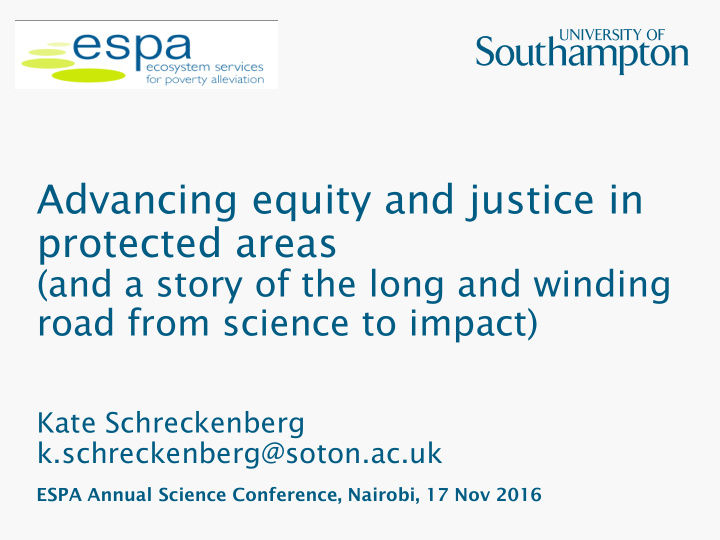



Advancing equity and justice in protected areas (and a story of the long and winding road from science to impact) Kate Schreckenberg k.schreckenberg@soton.ac.uk ESPA Annual Science Conference, Nairobi, 17 Nov 2016
"For me this is an issue about justice - justice between generations. There seems to be something fundamentally wrong with us destroying our oceans so our children and grand- children have absolutely nothing.“ Lewis Pugh, UN oceans patron 2 Kelvin Trautman
Victoria Tauli Corpuz: UN Special Rapporteur of the Human Rights Council on the rights of indigenous people Report to the UN highlights concern about: “the human rights violations that conservation measures have caused indigenous peoples worldwide, notably by the expropriation of land, forced displacement, denial of self-governance, lack of access to livelihoods and loss of culture and spiritual sites, non-recognition of their own authorities and denial of access to justice and reparation, including restitution and compensation” (Tauli Corpuz, 2016, p6). 3
In a study of 34 PAs…. Biodiversity is declining, poaching persists Consistent neglect and some outright violations of human rights Creation of 26 PAs led to partial or complete displacement of local people Communities support conservation but not PAs diminish already the prevalent models strained livelihoods imposed upon them (while extractive industries flourish) Indigenous people suffer 4 disproportionately
How big a problem is it? Aichi Biodiversity Target 11 of the CBD: “By 2020, at least 17 per cent of terrestrial and inland water, and 10 per cent of coastal and marine areas,…are conserved through effectively and equitably managed ….. protected areas and other effective area- based conservation measures” About half of protected areas are established on lands traditionally occupied and used by indigenous peoples (Stevens, 2014) 5
Contributing strands of work… ESPA ‘equity’ project 6
Contributing strands of work… Social assessment of Just ecosystem protected areas management (Sikor, UEA) (Franks, IIED) Ecosystem services, wellbeing and justice (Sikor and Dawson, UEA) 7
‘Equity, justice and well-being in ecosystem governance’ workshop hosted by IIED in March 2015 Neil Dawson Adrian Martin Trevor Sandwith Phil Franks Dilys Roe New project idea! 8 Kate Schreckenberg
ESPA Regional Opportunities Fund: Small grants scheme To provide the PA community with a framework for achieving more just and equitable governance of new and existing PAs at both site and systems level. £75,000 (from 1 st Oct 2015 for 12 months) 9
Phase 1: Framework development Nov 2015: Workshop to develop framework 10
Phase 2: Validation of framework Jan 2016 – IUCN and UNEP-WCMC meeting on Green List of Protected and Conserved Areas March 2016, Uganda – CBD Secretariat capacity- building meeting for national reps included a session on equity April – July 2016 Field validation – Three sites chosen based on region (East Africa), field contacts, different governance systems and types of equity issue 11
Bwindi Impenetrable National Park, Uganda 12
Amani Nature Reserve, Tanzania 13
Loita Community Forest, Kenya 14
July 2016 – validation workshop, Nairobi Confirmed framework dimensions and principles No omissions – No redundancy – Highlighted some areas for clarification Gender – ‘relevant actors’ – ‘trade-offs’ – Timeliness of promised actions – Strong support for more work at national (systems) level 15
The equity framework 16
Recognition 1. Recognition and respect for human rights 2. Recognition and respect for statutory and customary property rights 3. Recognition and respect for the rights of Indigenous Peoples, women and marginalized groups 4. Recognition of different identities, values, knowledge systems and institutions 5. Recognition of all relevant actors and their diverse interests, capacities and powers to influence 6. Non-discrimination by age, ethnic origin, language, gender, class and beliefs 17 Selsen Kucukuste/Atlas
Procedure 7. Full and effective participation GIZ-CEROSAM of all relevant actors in decision-making 8. Clearly defined and agreed responsibilities of actors 9. Accountability for actions and inactions 10. Access to justice, including an effective dispute- resolution process 11. Transparency supported by timely access to relevant information in appropriate forms 12. FPIC for actions that may affect the property rights of Indigenous Peoples and local communities 18
Distribution 13. Identification and assessment of costs, benefits and risks and their distribution and trade-offs 14. Effective mitigation of any costs to Indigenous Peoples and local communities 15. Benefits shared among relevant actors according to one or more of the following criteria: • equally between relevant actors or • according to contribution to conservation, costs incurred, recognised rights and/or the priorities of the poorest 16. Benefits to present generations do not compromise benefits to future generations 19
Enabling conditions 1. Legal, political and social recognition of all protected area governance types 2. Relevant actors have awareness and capacity to achieve recognition and participate effectively 3. Alignment of statutory and customary laws and norms 4. An adaptive, learning approach 20
Phase 3: Reflection and dissemination Next steps: Develop an ‘understanding equity’ guide and follow-on research proposal 21
What have I learned about science- policy impact? Keep the faith – wait for the right ‘hook’ Serendipity Networks, networks, networks Boundary Keep talking organisations, Advantage to your and professional of outsider funders communicators looking in 22 http://pudgemountain deviantart com/art/Long-and-Winding-Road-Ahead-Sign-353965929
Recommend
More recommend